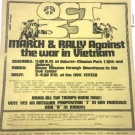Analyze the women’s rights movement from the era of Elizabeth Stanton and Susan Anthony and the passage of the Nineteenth Amendment to the movement launched in the 1960s, including differing perspectives on the roles of women
California History-Social Science Project
Resources & professional learning for K-12 history-social science

